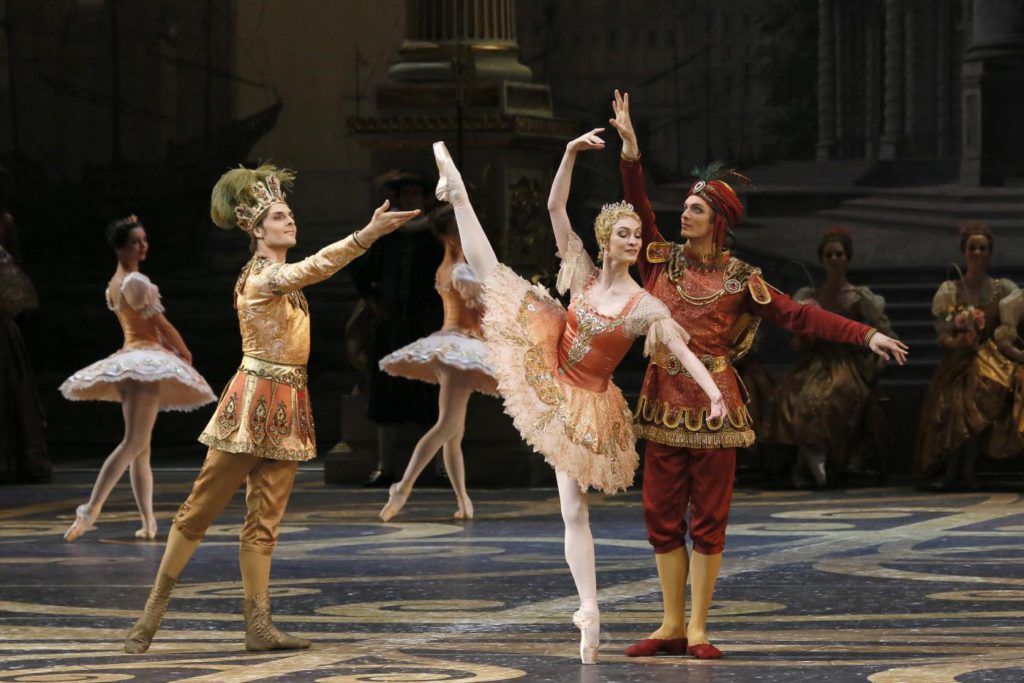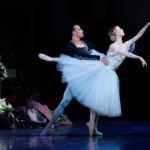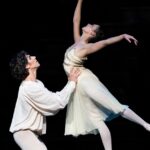The Sleeping Beauty is a celebrated ballet whose score was composed by the renowned Russian composer Pyotr Ilyich Tchaikovsky, with choreography by Marius Petipa—a renowned choreographer at the Mariinsky Theatre. Completed in 1889, it premiered at the Mariinsky Theatre in St. Petersburg on January 15, 1890. This enchanting ballet draws inspiration from Charles Perrault’s fairy tale, seamlessly weaving in characters from other Perrault stories and elements from the Brothers Grimm’s version. Since its creation, The Sleeping Beauty has been a pillar of the classical ballet repertory.
The Eternal Struggle Between Good and Evil
The ballet unfolds in a classic three-act structure: the christening of Princess Aurora, her sixteenth birthday and the fateful curse, the Prince’s quest and Aurora’s awakening, and finally, a joyous wedding celebration. This structure adheres to the traditional ballet-féerie format, beginning with a prologue that establishes the conflict between good and evil.
The Blessing and the Curse: A Tale of Two Fates

The story commences with Princess Aurora’s christening, where benevolent fairies bestow gifts upon her. However, the malevolent Carabosse, an uninvited guest, casts a dark spell, cursing Aurora to die on her sixteenth birthday by pricking her finger on a spindle.
The Lilac Fairy, however, intervenes, tempering the curse. Instead of death, Aurora will fall into a deep sleep for one hundred years, to be awakened by a true love’s kiss. This act establishes the central conflict between good and evil that drives the narrative.
The Fulfillment of the Curse: A Kingdom Asleep
On Aurora’s sixteenth birthday, despite precautions, Carabosse’s curse takes effect. Aurora pricks her finger on a spindle, and the entire kingdom, including its inhabitants, falls into a deep slumber. This act symbolizes the temporary triumph of evil, plunging the kingdom into a state of suspended animation.
However, this period of slumber also represents a period of waiting, a time for good to gather its strength and prepare for the inevitable confrontation with evil.
The Prince’s Quest and the Awakening: A Triumph of Love
Act II follows Prince Désiré’s journey as he is guided by the Lilac Fairy towards the enchanted castle. Driven by a vision of Aurora, he confronts the challenges that lie in his path. His quest to awaken Aurora transcends a simple rescue mission; it represents a battle between good and evil, a struggle to overcome the darkness that has enveloped the kingdom.
Finally, Prince Désiré reaches the sleeping Aurora. With a true love’s kiss, he breaks the spell, awakening her and restoring life to the kingdom. This act signifies the ultimate triumph of good over evil, a testament to the power of love and hope.
A Celebration of Love and Triumph
The ballet concludes with a magnificent wedding celebration, attended by a dazzling array of fairytale characters, including Puss in Boots and Red Riding Hood. This joyous occasion symbolizes the restoration of the kingdom and the reign of love and happiness.
A Legacy of Choreographic Brilliance
Marius Petipa, the esteemed choreographer at the Mariinsky Theatre, was entrusted with bringing this fairy tale to life. Collaborating with Ivan Vsevolozhsky, who also penned the libretto and designed the stunning sets and costumes, Petipa created a ballet that paid homage to Tsar Alexander III by referencing the court of Louis XIV.
Petipa’s Enduring Legacy
Petipa’s The Sleeping Beauty stands as a cornerstone of classical ballet. His meticulous choreography, with its emphasis on classical technique and intricate details, highlights the exceptional skill of the dancers.
The prologue introduces the contrasting forces of good and evil: the benevolent Lilac Fairy and the malevolent Carabosse. Observe how their movements – the Lilac Fairy’s graceful elegance versus Carabosse’s menacing gestures – vividly portray their opposing natures.
Act I showcases Aurora’s dazzling debut, featuring several challenging variations and the iconic Rose Adagio. Watch for her confident balances as she gracefully moves from one suitor to another.
The wedding pas de deux, a demanding feat for any ballerina, is a highlight of Act III. Notice how some steps from the Rose Adagio are elegantly reprised, and observe the breathtaking “fish dives” where Aurora seemingly dives through the prince’s arms. These awe-inspiring moments, though not originally part of the ballet, have become iconic features of the production.
While some may view The Sleeping Beauty as a cliché, it remains a pinnacle of the French-Russian ballet tradition. Petipa’s emphasis on graceful execution and impeccable technique, evident in every movement, makes The Sleeping Beauty an enduring testament to his genius and a challenging benchmark for dancers worldwide.
Reinterpretations and Modern Adaptations
The Sleeping Beauty has been reimagined countless times, with each production offering unique interpretations of the choreography and staging. From traditional stagings to contemporary adaptations, choreographers continue to find inspiration in this timeless tale.
Sir Peter Wright’s 1981 production for the Dutch National Ballet, with designs by Philip Prowse, is considered a successful example of a modern adaptation. This production honors Petipa’s original vision while incorporating contemporary sensibilities, ensuring that The Sleeping Beauty remains relevant and engaging for audiences of all ages.
The Musical Tapestry of The Sleeping Beauty
Tchaikovsky’s score is an integral part of The Sleeping Beauty’s lasting appeal. Despite his initial reservations about composing for ballet, he created a masterpiece that perfectly complements the choreography.
Musical Themes and Their Significance

Tchaikovsky’s music is a symphony of emotions, ranging from joyful and triumphant to melancholic and eerie. The score masterfully enhances the narrative, underscoring the shifting moods and emotions of the characters. For instance, the music swells with joy during the christening, grows ominous as Carabosse casts her curse, and transitions to a melancholic tone as the kingdom falls asleep.
Tchaikovsky also composed distinct themes for characters such as the wicked Carabosse and the Lilac Fairy. These themes are intricately woven throughout the score, highlighting their relationship and the Lilac Fairy’s power to counter Carabosse’s curse.
- Carabosse’s Theme: Dark and menacing, this theme reflects the character’s evil nature.
- The Lilac Fairy’s Theme: In contrast, this theme is bright and serene, symbolizing her benevolence and power.
Contemporary Interpretations
Tchaikovsky’s music for The Sleeping Beauty is still considered a complete masterpiece, so changes are made only when necessary. Modern versions often respect the original but adjust it to better suit new tastes, times, or performing styles.
For example, the original ballet is quite long (about 4 hours), including many festive scenes and extras. In modern versions, some of the music may be shortened or omitted to reduce the performance time to about 2-3 hours. Some of the long repetitions in Tchaikovsky’s original music, such as in the Grand Pas de Deux or the solo dances, may be edited to better suit the dancers’ abilities and the program’s time.
Contemporary productions may incorporate new orchestral arrangements or utilize innovative sound design to enhance the theatrical experience.
Costumes: A Visual Spectacle
The costumes in The Sleeping Beauty are not merely adornments; they are integral to the storytelling.
The Role of Costumes in Character and Setting

The costumes in The Sleeping Beauty are carefully crafted to reflect the personality and role of each character, adding depth to the storytelling. For example, Princess Aurora’s costumes are opulent and elegant, highlighting her royal status and delicate beauty. In contrast, Carabosse’s dark and menacing attire evokes fear and foreboding, perfectly capturing her malevolent nature. Meanwhile, the benevolent fairies are dressed in light, airy garments that symbolize their purity and kindness.
In addition to their design, the use of color plays a significant role in enhancing the mood and storyline. Bright hues, along with gold and silver, are typically reserved for joyful scenes, such as the wedding, to create a celebratory atmosphere. On the other hand, dark, bold, and cool tones, like deep blue or black, dominate Carabosse’s scenes and moments of danger, underscoring the tension and drama. Together, these elements work in harmony to immerse the audience in the enchanting world of the ballet.
Historical Influences on Costume Design
Costumes play a crucial role in defining the time period, location, and atmosphere of each scene. This is particularly evident in the stark contrast between the costumes in Act I and Act II, which reflects the passage of one hundred years and highlights the evolution of fashion over time. To achieve this authenticity, costume designers draw inspiration from various historical periods, such as the Renaissance, Rococo, and Victorian eras, ensuring that each outfit aligns with the narrative’s setting and characters.
The Lasting Influence of The Sleeping Beauty
Although the premiere received critical acclaim, with some critics describing the ballet as ‘too serious’ and the music as ‘too symphonic,’ its international success came posthumously. Over time, it became one of the world’s most renowned classical ballets and has been restaged numerous times, including a 1999 revival of the 1890 Mariinsky Ballet production, which featured the original sets and costumes.
Evolving Perspectives on Aurora

When The Sleeping Beauty premiered in 1890, Aurora was portrayed within the artistic and societal context of the time-as an idealized female figure in the traditional mold, characterized by grace, elegance, and primarily defined by her role in the storyline (being blessed, cursed, and ultimately saved by love). Over time, however, perceptions of Aurora’s character have evolved. Modern critics and audiences have begun to notice the deeper aspects of her role through both the narrative and choreography.
Today, Aurora is often portrayed as a character with inner strength, taking an active role in the story rather than being merely a passive beauty. Contemporary productions highlight this evolution, focusing on her agency and her active participation in shaping her own destiny.
Influence on Other Art Forms
The ballet The Sleeping Beauty has significantly influenced various art forms, inspiring adaptations that incorporate its music, themes, and choreography while reinterpreting the story in new ways.
In cinema, Disney’s 1959 animated film Sleeping Beauty draws heavily from Tchaikovsky’s ballet. The film’s score integrates several segments from the ballet’s original composition, creating a direct connection between the two works and preserving the essence of the classical production.
In musical theater, British choreographer Matthew Bourne reimagined The Sleeping Beauty with a fresh perspective. His production blends classical ballet with contemporary dance, offering audiences a unique retelling of the timeless tale through innovative staging and movement.
Conclusion

The Sleeping Beauty, a timeless masterpiece of classical ballet, continues to enchant audiences worldwide. Tchaikovsky’s magnificent score, combined with Petipa’s masterful choreography and the enduring power of the fairy tale, ensures that this enchanting production will remain a cornerstone of the ballet repertoire for generations to come.
✉️ Stay Connected — Subscribe for Weekly Updates
Discover timeless stories, practical wisdom, and beautiful culture — delivered straight to your inbox.
*We only share valuable insights — no spam, ever.






